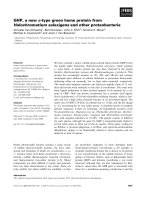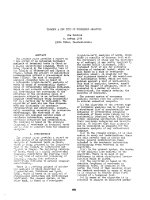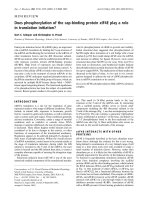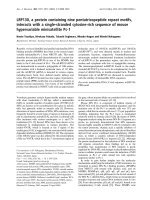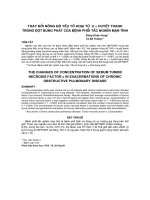Báo cáo y học: " Does a new polyomavirus contribute to Merkel cell carcinoma" pot
Bạn đang xem bản rút gọn của tài liệu. Xem và tải ngay bản đầy đủ của tài liệu tại đây (83.74 KB, 4 trang )
Genome
BBiioollooggyy
2008,
99::
228
Minireview
DDooeess aa nneeww ppoollyyoommaavviirruuss ccoonnttrriibbuuttee ttoo MMeerrkkeell cceellll ccaarrcciinnoommaa??
Kelly M Garneski*, James A DeCaprio
†
and Paul Nghiem*
‡
Addresses: *Departments of Medicine/Dermatology and Pathology, University of Washington, Seattle, WA 98109, USA.
†
Department of
Medical Oncology, Dana-Farber Cancer Institute, and Department of Medicine, Brigham and Women’s Hospital and Harvard University,
Boston, MA 02115, USA.
‡
Clinical Research Division, Fred Hutchinson Cancer Research Center, Seattle, WA 98109, USA.
Correspondence: Paul Nghiem. Email:
AAbbssttrraacctt
A new technique designed to hunt for non-human transcripts has identified a novel SV40-like
virus present in the majority of Merkel cell carcinomas. Here we examine what it will take to
determine whether or not this virus contributes to carcinogenesis.
Published: 17 June 2008
Genome
BBiioollooggyy
2008,
99::
228 (doi:10.1186/gb-2008-9-6-228)
The electronic version of this article is the complete one and can be
found online at />© 2008 BioMed Central Ltd
Merkel cell carcinoma (MCC) is an uncommon and aggressive
skin cancer. More than one-third of MCC patients will die
from this cancer, making it twice as lethal as malignant
melanoma [1]. The reported incidence of MCC has tripled
over the past 20 years because of improved detection and a
rise in the number of elderly and immunosuppressed indi-
viduals who are at risk [2]. It is estimated that there will be
1,500 new cases of MCC this year in the United States [3].
There has been a long-standing interest in the etiology of
MCC. Several lines of evidence suggest a strong link between
MCC and ultraviolet light exposure. For example, the inci-
dence of MCC is higher at more equatorial latitudes [4], 81%
of primary tumors occur on sun-exposed skin [1], and
Caucasians have the greatest risk. MCC incidence is also
strongly coupled with advanced age; indeed, 90% of people
diagnosed with MCC are over the age of 50 [1].
Importantly, there is a striking epidemiologic association
between immunosuppression and MCC. Chronically
immunosuppressed individuals are more than 15 times more
likely to develop MCC than are age-matched controls [1]. In
particular, many forms of T-lymphocyte immune suppression
are linked with MCC: HIV infection [5], solid organ
transplantation [6] and chronic lymphocytic leukemia [1] are
all associated with a ten-fold or greater increased risk of
developing MCC. MCC is more frequently lethal in
immunosuppressed patients, with a reported disease-specific
mortality of up to 56% [7]. Interestingly, there are several case
reports of MCC regression following restoration of immune
function [8,9]. These intriguing clues have led many to suspect
an infectious contribution to MCC.
AA nneeww tteecchhnniiqquuee ffiinnddss aa nneeww vviirruuss
Patrick Moore and Yuan Chang are well known for their
discovery of the Kaposi’s sarcoma-associated herpesvirus
(KSHV) [10]. Nearly a decade ago, they became interested in
MCC because of its strong links to immunosuppression. In a
recent paper in Science (Feng et al. [11]) their team reports the
development of a technique known as digital transcriptome
subtraction (DTS; see [12]) and its use to look for viral RNA
sequences in MCC cells. The authors first sequenced nearly
the entire transcriptome of several MCC tumors using pyro-
sequencing technology [11]. Pyrosequencing is a massively
high-throughput, bead-based chemiluminescent sequencing
method that produces large numbers of medium-length
sequences (typically 300 nucleotides) simultaneously. The
resulting MCC cDNA sequences were filtered to eliminate low-
complexity sequences, known human di- and trinucleotide
repeat sequences, and poly(A) and poly(T) tracts. The
remaining ‘high-fidelity’ sequences were compared to human
transcripts in the RefSeq database using an in silico approach
similar to that described by Weber et al. [13].
Feng et al. [11] obtained 382,747 high-fidelity MCC cDNA
sequences, of which 99.4% aligned closely with known
human transcripts. One sequence that did not align had high
sequence identity with the human BK polyomavirus
T antigen. This transcript sequence was extended using
rapid amplification of cDNA ends (RACE), and then used to
develop bidirectional primers for viral genome sequencing.
Several successive steps of genome walking led to the
discovery of two nearly identical full-genome sequences of a
novel human DNA polyomavirus, which the authors named
Merkel cell polyomavirus (MCPyV or MCV; GenBank
accession number EU375803, GenBank EU375804).
Feng et al. [11] screened ten MCC tumors for MCPyV and
found that seven were strongly positive for MCPyV DNA by
PCR and an additional tumor was weakly positive. The
strength of the PCR signals raised the question of whether
the viral DNA was integrated in a clonal fashion. Genomic
DNA from MCC tumors was digested with two restriction
enzymes and analyzed by Southern hybridization using a
MCPyV DNA probe. From the observed banding patterns,
five of the eight MCPyV-positive MCC tumors revealed
monoclonal integration of the virus, another tumor had a
monoclonally integrated viral concatemer, and two addi-
tional tumors had an indeterminate integration pattern. For
one tumor with a monoclonal integration pattern, both
primary and metastatic tumor tissue was available, and both
specimens showed an identical viral integration pattern,
suggesting that integration of MCPyV preceded MCC tumor
metastasis. Furthermore, the distinct integration patterns
between tumors imply that the virus integrated at different
locations within the human genome in the different tumors.
Although no direct assessment of viral RNA or protein
expression was described, the DTS results indicated that at
least one MCC tumor expressed viral RNA sequences corres-
ponding to the large T antigen. As discussed below, poly-
omavirus large T antigens have proven transforming abilities
in mammalian cells.
PPoollyyoommaavviirruusseess aanndd ccaarrcciinnooggeenneessiiss
Polyomaviruses are a genus of non-enveloped viruses with a
circular double-stranded DNA genome of approximately 5 kb.
It has been well established that many polyomaviruses are
able to transform mammalian cells [14]. The best-
characterized polyomavirus, SV40, was originally discovered
as a contaminant in the primary monkey kidney cells used to
prepare early batches of the polio vaccine and was subse-
quently shown to induce tumors in newborn hamsters [15,16].
Polyomaviruses do not encode the entire repertoire of
proteins necessary for viral DNA replication. Instead, these
viruses hijack the machinery of a dividing host cell.
Polyomaviruses express genes in two waves: early and late.
The early-expressed genes, including large and small
T antigens, bind to host proteins to force the cell into
S phase (the cell-cycle phase when the DNA is replicated)
and facilitate viral replication. The late genes encode
components of the viral coat and enable lysis.
Large T antigen performs diverse functions that require
discrete protein domains, which include the DNA J, origin-
binding and helicase domains. These facilitate viral replica-
tion by binding to cellular replication proteins, including
Hsc70 (HSPA8), DNA polymerase, primase, topoisomerase I,
and RPA (Figure 1) [17]. SV40 large T antigen also binds
cellular growth regulators including the tumor suppressors
pRb and p53, to promote cell growth and entry into S phase.
Importantly, the predicted MCPyV large T antigen contains
many of the features common to oncogenic polyomaviruses,
including an LxCxE motif that may directly bind pRb.
There are two published MCPyV genome sequences, ob-
tained from sequencing MCPyV DNA integrated into two
MCC tumors. In both sequences, premature stop codons are
predicted within the second exon of large T after the pRb-
and Hsc70-binding domains but before the helicase domain
required for viral replication. Such truncations were
probably selected during tumor development to render the
large T antigen protein inactive for viral DNA replication
functions. If the large T antigen were intact, replication
initiated at an integrated origin could lead to genomic
instability and cell death. Indeed, in permissive cells
transformed by SV40, the large T antigen is often mutated
such that the viral replication functions (helicase activity)
are inactive but some cell-cycle progression functions (pRb
binding) are preserved [18,19]. Thus, the predicted protein
products of the two truncated MCPyV large T antigens are
likely to maintain pro-carcinogenic effects but have lost
their cell-lethal effects in a fashion similar to the SV40 large
T antigens found in virus-induced animal cancers.
Polyomavirus family members are known to have two other
T antigen proteins with transforming ability. MCPyV is
predicted to express a small T antigen that is able to bind to
and inactivate protein phosphatase 2A (PP2A). A few poly-
omaviruses express an additional middle T antigen that
binds Src and other signaling proteins. On the basis of the
published sequences, it is unlikely that MCPyV encodes a
middle T antigen.
Five polyomaviruses have been discovered in humans: BK,
JC, WU, KI (all named after the patients or institutions
where they were discovered) and now MCPyV. Serologic
evidence of BK virus infection can be detected in nearly all
humans and active BK infection causes nephritis in
immunocompromised patients, particularly renal transplant
recipients [20]. The JC virus also commonly infects humans
and can cause progressive multifocal leukencephalopathy in
immunocompromised persons [21]. BK virus has been
detected in prostate cancer and JC virus in a variety of lung,
brain, colon and other tumor types [21]. However, in these
cancers the BK and JC viruses have been found to be
episomal and not integrated; thus, their contribution to
carcinogenesis remains unclear. WU and KI viruses were
recently discovered in nasopharyngeal secretions [22,23].
/>Genome
BBiioollooggyy
2008, Volume 9, Issue 6, Article 228 Garneski
et al.
228.2
Genome
BBiioollooggyy
2008,
99::
228
Merkel cell polyomavirus is currently the only polyomavirus
with demonstrated integration into human tumor DNA.
DDooeess MMCCPPyyVV ccoonnttrriibbuuttee ttoo MMCCCC ppaatthhooggeenneessiiss??
Several significant observations suggest that MCPyV
contributes to the development of a subset of MCC: it is
present in a substantial portion of MCC tumors, viral
integration appears to be an early event, large T antigen
transcript is expressed in MCC tumors, and the MCPyV
large T antigen predicted protein sequence shares key
homology with the SV40 T antigen oncoprotein [11].
Furthermore, the strong epidemiologic links between
immunosuppression and the incidence and severity of
MCC support an infectious etiology.
In contrast, there are also arguments against an essential
role for MCPyV in MCC oncogenesis. It appears that
MCPyV infection is not necessary for the development of
MCC; indeed, two out of ten reported MCC cases were
MCPyV negative [11]. This distinguishes MCPyV from
other cancer-causing viruses such as KSHV and human
papillomavirus (HPV) where viral sequences are found in
nearly 100% of tumors. The epidemiology of MCC can also
argue against the important involvement of any virus in the
disease. MCC incidence is strongly linked to sun exposure
and MCC very rarely develops in persons with heavily
pigmented skin. Furthermore, there have been no reports
of clusters of MCC or of several people in the same family
developing MCC, as might be expected were it due to a
viral infection.
The discovery of MCPyV raises several interesting questions.
It will be important to determine the prevalence of MCPyV
in healthy individuals as well as to test other cancers for the
presence of integrated MCPyV. Furthermore, it will be
helpful to distinguish whether MCPyV infection is involved
in tumor initiation and/or tumor maintenance, especially in
regard to the viral T antigens. It will be especially important
to determine whether viral proteins are continually
expressed in MCC tumors, and if these viral genes are
required for the ongoing survival of cancer cells. These
studies will help guide efforts to design potential small-
molecule drugs or anti-tumor vaccines.
For the moment, whether MCPyV promotes carcinogenesis
in MCC or other cell types remains a captivating question. It
is clear that the discovery of MCPyV by Chang and Moore
and their team [11] has opened up important new avenues
that should illuminate MCC biology and also that the DTS
technique may be applicable to the discovery of other
pathogens.
RReeffeerreenncceess
1. Heath M, Jaimes N, Lemos B, Mostaghimi A, Wang LC, Penas PF,
Nghiem P:
CClliinniiccaall cchhaarraacctteerriissttiiccss ooff MMeerrkkeell cceellll ccaarrcciinnoommaa aatt ddiiaaggnnoo
ssiiss iinn 119955 ppaattiieennttss:: tthhee AAEEIIOOUU ffeeaattuurreess
J Am Acad Dermatol
2008,
5588::
375-381.
2. Hodgson NC:
MMeerrkkeell cceellll ccaarrcciinnoommaa:: cchhaannggiinngg iinncciiddeennccee ttrreennddss
J
Surg Oncol
2005,
8899::
1-4.
3. Lemos B, Nghiem P:
MMeerrkkeell cceellll ccaarrcciinnoommaa:: mmoorree ddeeaatthhss bbuutt ssttiillll nnoo
ppaatthhwwaayy ttoo bbllaammee
J Invest Dermatol
2007,
112277::
2100-2103.
4. Agelli M, Clegg LX:
EEppiiddeemmiioollooggyy ooff pprriimmaarryy MMeerrkkeell cceellll ccaarrcciinnoommaa iinn
tthhee UUnniitteedd SSttaatteess
J Am Acad Dermatol
2003,
4499::
832-841.
/>Genome
BBiioollooggyy
2008, Volume 9, Issue 6, Article 228 Garneski
et al.
228.3
Genome
BBiioollooggyy
2008,
99::
228
FFiigguurree 11
Alignment of key functional domains of MCPyV, JC, and SV40 large T antigens. At the top is a cartoon of the protein structure of the predicted MCPyV
large T antigen, based on its homology to the well-characterized SV40 large T antigen (modified from [17]). Underneath are expanded alignments for the
Hsc70-binding motif and the pRb-binding motif, comparing the putative MCPyV large T antigen with the JC and SV40 large T antigens. Importantly, as
indicated by the bold underlines below the zoom-ins, both the HPDK Hsc70-binding motif and the LxCxEx Rb-binding motifs are preserved in the
predicted MCPyV large T antigen. Noted on the cartoon are the locations of the premature stop (MCV350) and frameshift (MCV339) mutations of the
two known MCPyV genomes [11]. These predicted truncated proteins potentially preserve some of the cell-cycle progression activities of the amino
terminus of large T but prevent cell-lethal genomic instability related to the replicative functions of the carboxyl terminus.
100 200 300 400 500 600 700 817
MCV350 MCV339
Dna J
Rb Ori binding doman Helicase
0
MCPyV
JC
H
H P D K G G N P V
L
H P D K G G D E D
F
H P D K G G D E E
SV40
Hsc70-binding motif
D L F C D E S L S S P E P P
D L F C
H E E M F A S D D E
N
L F C
S E E M P
S S D D E
MCPyV
JC
SV40
Rb-binding motif
5. Engels EA, Frisch M, Goedert JJ, Biggar RJ, Miller RW:
MMeerrkkeell cceellll
ccaarrcciinnoommaa aanndd HHIIVV iinnffeeccttiioonn
Lancet
2002,
335599::
497-498.
6. Miller RW, Rabkin CS:
MMeerrkkeell cceellll ccaarrcciinnoommaa aanndd mmeellaannoommaa:: eettiioolloogg
iiccaall ssiimmiillaarriittiieess aanndd ddiiffffeerreenncceess
Cancer Epidemiol Biomarkers Prev
1999,
88::
153-158.
7. Penn I, First MR:
MMeerrkkeell’’ss cceellll ccaarrcciinnoommaa iinn oorrggaann rreecciippiieennttss:: rreeppoorrtt
ooff 4411 ccaasseess
Transplantation
1999,
6688::
1717-1721.
8. Friedlaender MM, Rubinger D, Rosenbaum E, Amir G, Siguencia E:
TTeemmppoorraarryy rreeggrreessssiioonn ooff MMeerrkkeell cceellll ccaarrcciinnoommaa mmeettaassttaasseess aafftteerr cceess
ssaattiioonn ooff ccyycclloossppoorriinnee
Transplantation
2002,
7733::
1849-1850.
9. Burack J, Altschuler EL:
SSuussttaaiinneedd rreemmiissssiioonn ooff mmeettaassttaattiicc MMeerrkkeell cceellll
ccaarrcciinnoommaa wwiitthh ttrreeaattmmeenntt ooff HHIIVV iinnffeeccttiioonn
J R Soc Med
2003,
9966::
238-239.
10. Chang Y, Cesarman E, Pessin MS, Lee F, Culpepper J, Knowles DM,
Moore PS:
IIddeennttiiffiiccaattiioonn ooff hheerrppeessvviirruuss lliikkee DDNNAA sseeqquueenncceess iinn AAIIDDSS
aassssoocciiaatteedd KKaappoossii’’ss ssaarrccoommaa
Science
1994,
226666::
1865-1869.
11. Feng H, Shuda M, Chang Y, Moore PS:
CClloonnaall iinntteeggrraattiioonn ooff aa ppoollyy
oommaavviirruuss iinn hhuummaann MMeerrkkeell cceellll ccaarrcciinnoommaa
Science
2008,
331199::
1096-
1100.
12. Feng H, Taylor JL, Benos PV, Newton R, Waddell K, Lucas SB, Chang
Y, Moore PS:
HHuummaann ttrraannssccrriippttoommee ssuubbttrraaccttiioonn bbyy uussiinngg sshhoorrtt
sseeqquueennccee ttaaggss ttoo sseeaarrcchh ffoorr ttuummoorr vviirruusseess iinn ccoonnjjuunnccttiivvaall ccaarrcciinnoommaa
J Virol
2007,
8811::
11332-11340.
13. Weber G, Shendure J, Tanenbaum DM, Church GM, Meyerson M:
IIddeennttiiffiiccaattiioonn ooff ffoorreeiiggnn ggeennee sseeqquueenncceess bbyy ttrraannssccrriipptt ffiilltteerriinngg aaggaaiinnsstt
tthhee hhuummaann ggeennoommee
Nat Genet
2002,
3300::
141-142.
14. Stewart SE, Eddy BE, Gochenour AM, Borgese NG, Grubbs GE:
TThhee
iinndduuccttiioonn ooff nneeooppllaassmmss wwiitthh aa ssuubbssttaannccee rreelleeaasseedd ffrroomm mmoouussee
ttuummoorrss bbyy ttiissssuuee ccuullttuurree
Virology
1957,
33::
380-400.
15. Sweet BH, Hilleman MR:
TThhee vvaaccuuoollaattiinngg vviirruuss,, SS VV 4400
.
Proc Soc Exp
Biol Med
1960,
110055::
420-427.
16. Rabson AS, Kirschstein RL:
IInndduuccttiioonn ooff mmaalliiggnnaannccyy
iinn vviittrroo
iinn
nneewwbboorrnn hhaammsstteerr kkiiddnneeyy ttiissssuuee iinnffeecctteedd wwiitthh ssiimmiiaann vvaaccuuoollaattiinngg vviirruuss
((SSVV4400))
Proc Soc Exp Biol Med
1962,
111111::
323-328.
17. Ali SH, DeCaprio JA:
CCeelllluullaarr ttrraannssffoorrmmaattiioonn bbyy SSVV4400 llaarrggee TT
aannttiiggeenn:: iinntteerraaccttiioonn wwiitthh hhoosstt pprrootteeiinnss
Semin Cancer Biol
2001,
1111::
15-23.
18. Pellegrini S, Dailey L, Basilico C:
AAmmpplliiffiiccaattiioonn aanndd eexxcciissiioonn ooff iinnttee
ggrraatteedd ppoollyyoommaa DDNNAA sseeqquueenncceess rreeqquuiirree aa ffuunnccttiioonnaall oorriiggiinn ooff rreeppllii
ccaattiioonn
.
Cell
1984,
3366::
943-949.
19. Syu LJ, Fluck MM:
SSiittee ssppeecciiffiicc iinn ssiittuu aammpplliiffiiccaattiioonn ooff tthhee iinntteeggrraatteedd
ppoollyyoommaavviirruuss ggeennoommee:: aa ccaassee ffoorr aa ccoonntteexxtt ssppeecciiffiicc oovveerr rreepplliiccaattiioonn
mmooddeell ooff ggeennee aammpplliiffiiccaattiioonn
J Mol Biol
1997,
227711::
76-99.
20. Acott PD, Hirsch HH:
BBKK vviirruuss iinnffeeccttiioonn,, rreepplliiccaattiioonn,, aanndd ddiisseeaasseess iinn
ppeeddiiaattrriicc kkiiddnneeyy ttrraannssppllaannttaattiioonn
Pediatr Nephrol
2007,
2222::
1243-
1250.
21. Caracciolo V, Reiss K, Khalili K, De Falco G, Giordano A:
RRoollee ooff tthhee
iinntteerraaccttiioonn bbeettwweeeenn llaarrggee TT aannttiiggeenn aanndd RRbb ffaammiillyy mmeemmbbeerrss iinn tthhee
oonnccooggeenniicciittyy ooff JJCC vviirruuss
Oncogene
2006,
2255::
5294-5301.
22. Allander T, Andreasson K, Gupta S, Bjerkner A, Bogdanovic G,
Persson MA, Dalianis T, Ramqvist T, Andersson B:
IIddeennttiiffiiccaattiioonn ooff aa
tthhiirrdd hhuummaann ppoollyyoommaavviirruuss
J Virol
2007,
8811::
4130-4136.
23. Gaynor AM, Nissen MD, Whiley DM, Mackay IM, Lambert SB, Wu
G, Brennan DC, Storch GA, Sloots TP, Wang D:
IIddeennttiiffiiccaattiioonn ooff aa
nnoovveell ppoollyyoommaavviirruuss ffrroomm ppaattiieennttss wwiitthh aaccuuttee rreessppiirraattoorryy ttrraacctt iinnffeecc
ttiioonnss
PLoS Pathog
2007,
33::
e64.
/>Genome
BBiioollooggyy
2008, Volume 9, Issue 6, Article 228 Garneski
et al.
228.4
Genome
BBiioollooggyy
2008,
99::
228


